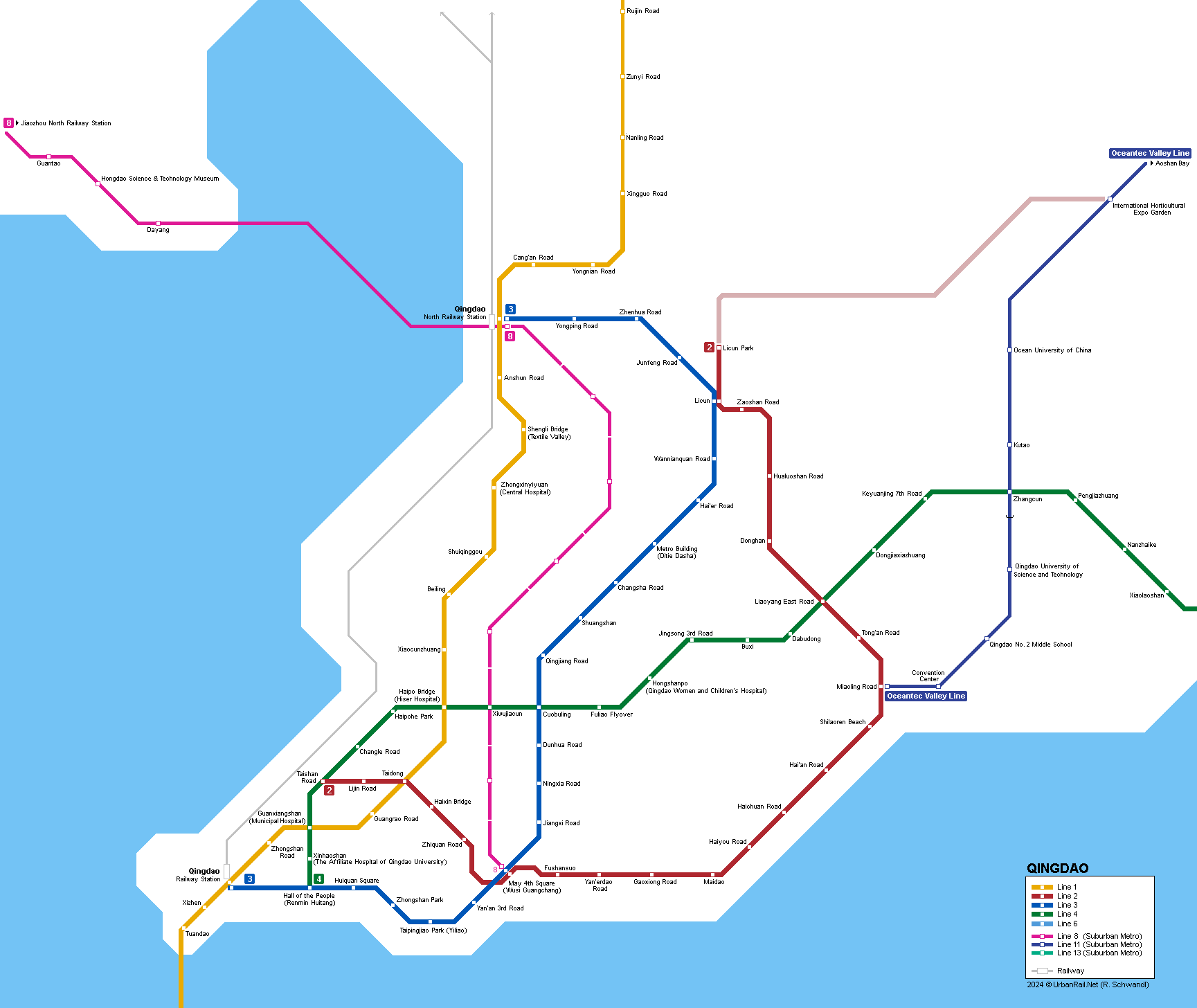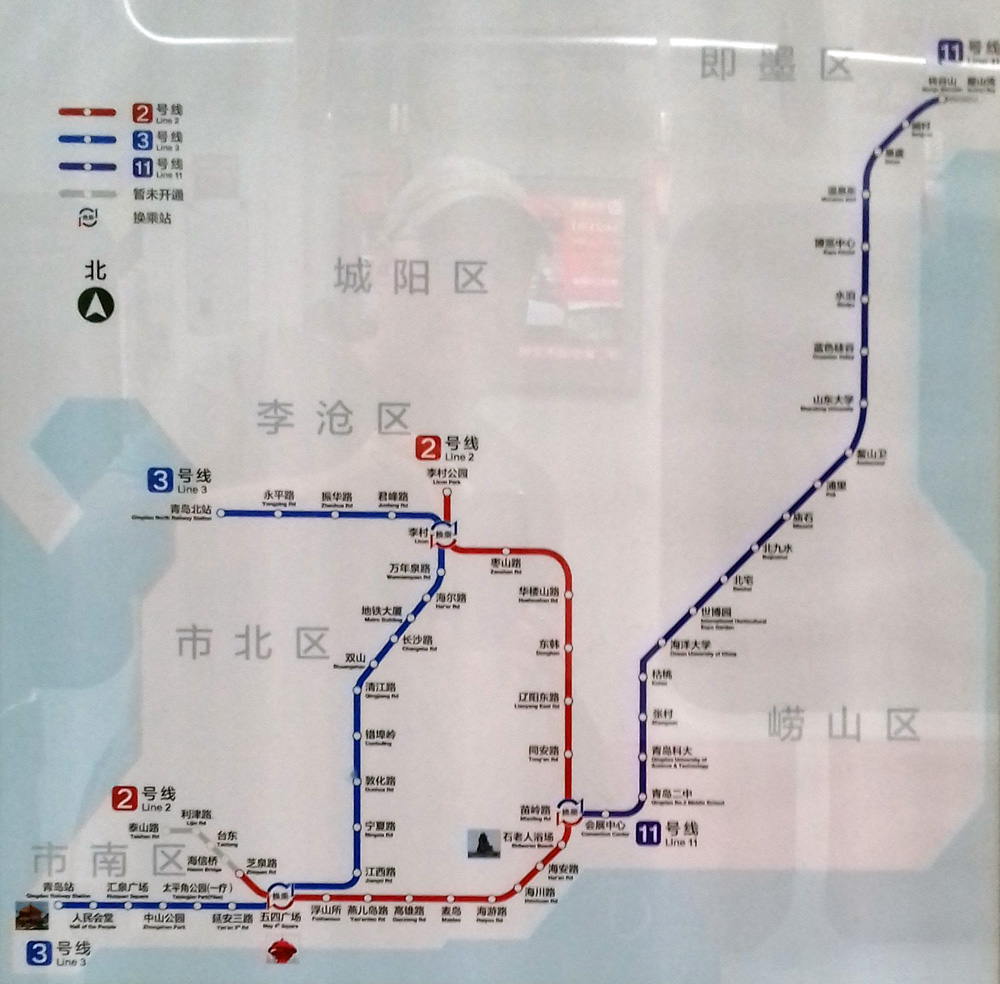
|
[ UrbanRail.Net ] [ Europe ] [ Americas ] [ Asia ] [ Africa ] [ Oceania ] [ News ] [ Books ] [ Links ] |
|
QINGDAO
|
| China |
|
System
|
|
Qingdao (Tsingtao), a city in eastern Shandong province, has some 2.7 million inhabitants. Construction of a 25 km subway line (M3) with 22 stations started in June 2009. The first section opened in Dec 2015. Meanwhile, more lines have been added:
|
|
Line
1
|
|
24 Dec 2020: Qingdao Beizhan (North Railway Station) - Dongguozhuang
(21.9
km; Xingguo Road – Dongguozhuang is part of
planned Line 7)
|
|
|
|
Line
2
|
|
10
Dec 2017: Zhiquan Road - Licun Gongyuan (21.2 km)
|
|
|
|
Line
3
|
|
16
Dec 2015: Qingdao Beizhan (North Railway Station) - Shuangshan (12
km)
|
|
|
|
Line
4
|
|
26
Dec 2022: Hall of the People – Dahedong (30.7 km)
|
|
|
|
Line
6
|
|
Tangential line on the south bank of the bay: 26 Apr 2024: Hengyunshan Road - Lingshan Bay (30.5 km)
|
|
Line
8
|
|
Suburban metro line to serve Jiaodong International Airport in the northwest 24
Dec 2020: Qingdao Beizhan (North Railway Station) - Jiaozhou North
Railway Station (48.3 km; 6.4 km elevated, 5.4 km underwater sea crossing)
|
|
|
|
Line
11 > Oceantec Valley Line
|
|
Suburban metro line (previously referred to as R1) - Miaoling Road - Aoshan Bay (58 km, 22 stations) 23
April 2018: Miaoling Road - Qiangu Mountain (54.6 km)
|
|
|
|
Line
13 > The West Coast Line
|
|
Suburban metro line (previously referred to as R3 and opened as line 13) along the southern coast of Qingdao; initially not connected to the rest of the network, until it was linked via line 1 once the underwater extension had been completed in Dec 2021. - 69.6 km, 23 stations; partly underground 26
Dec 2018: Jinggangshan Road - Dongjiakou Railway Station (66.8
km)
|
|
|
|
Links
|
|
Qingdao Metro (Official Site) Qingdao Metro at Wikipedia
|
|
Photos
|
| Impressions |
|
In January 2019, Craig Moore reports from Qingdao: Located on a stunning bay, the former German colony of Qingdao is a rapidly developing city with one of the highest GDPs in China, and is famed as the home of the Tsingtao Brewery. Urban rail came quite late here with the first service (Line 3) opening prior to Christmas 2015 as a 12km ‘half line’ serving only the north of the city. Yet, as with many cities in China, the intervening period has brought significant expansion as well as some useful service enhancements. Today, the Qingdao Metro Corporation (QMC) operates a four-line network of 166.1km (revenue km) (all third rail powered), however, as is the trend in several Chinese systems today, a significant part of the network is of suburban metro type and not fully urban. The Network
This line offers transfer to Line 3 at Wusiguangchang and Licun. At the former, there is cross platform transfer (west/west and east/east) with the two pairs of lines running parallel, separated by a central wall and lying beneath a broad ticket hall. Licun, is a ‘V’ shaped station with Line 3 lying below Line 2 and transfer across a large space above the platforms is required. At Miaoling Road there is a simple transfer to Line 11 with the new westbound line lying perpendicular and below Line 3 platforms. The stock is CRRC B type stock made up of six cars. The exterior is metallic with a yellow and orange side stripe which fragments to form various patters at the ends of the trains. There is a smart frontage with lights surrounding the large front window. The interior has dynamic strip maps, red and white lateral seating and dark wood veneer panelling at carriage ends. The lighting is also different, being made up of elongated ‘Os’ rather than long strips along the side of the carriage ceiling.. The original line (Line 3) opened in two stages at the end of 2015 and 2016 and now connects Qingdao North Railway Station (CRH) and Qingdao Railway Station, taking a more direct route north than the more circuitous Line 2. The underground line is the busiest on the network and serves the pleasant ‘old town’ before heading north under Nanjing Road to Licun and then running west to the massive Qingdaobei High Speed Station. Services run from 0600-2230 with identical service levels to Line 2. The 24.7km journey takes 46mins and includes 22 stations. Stations have a mix of ornate, green entrances or the more modern, angular glazed entrances and they follow the basic model with only occasional evidence of station individuality. White and pale grey tiling is predominant throughout and platforms are all island type with the exception of the North Station which has side platforms (separated by a central wall between the tracks). This station is huge, lying underneath the rail station with 4 entrances converging in a huge underground piazza with numerous entrance and exit points. CSR 6 car B type stock is used with white interiors and light-blue side seating, basic strip map and a more worn feel. The exterior has quite a bold livery with a broad dark turquoise band encasing the windows with a narrow orange band below. Line 11 has barrier free interchange with Line 2 and is a fully paid up member of the QMC family, but it does offer a different type of service. The 54.4km line runs between Laoshan and Jimo Districts but only the first 9 or 10km of the line can be described as urban. From leaving Miaoling Road the service has 4.6km of underground running (4 stations) before rising to an elevated structure just south of Zhangcun. From here the line soon begins to meander through hills, running alongside the Binhai highway as it heads north east. Here Line 11 offers a distinctly semi-rural outlook as it passes various settlements/industrial areas in the Qingdao Oceantec Valley, such as International Expo, International Horticultural Expo, Ocean University of China and Qingdao University of Science and Technology. The entire line has only 21 stations and some of the distances between them are lengthy (5km to 6km- especially around Miaoshi) and so line speeds are good. Being the terminus within the city, Miaoling Road is the busiest on the line but is small and cramped with narrow single platforms. The other underground stations are island type, and uninspiring, with many pillars, and a cluttered feel. The above ground stations are smart however, and have side platforms and half screens, with usual furnishings, and a lovely light wood bowed roof. The platforms also house glass panelled ‘air conditioned waiting rooms’ which is a nice touch. The line is surprisingly busy quite a way into the route and it operates 8min headways from 0630-2130 - the trip takes around 1 hour. The 4 car sets are CRRC B type have streamlined frontages and are metallic with a blue stripe above the widows. The interior has identical lighting style to Line 3 stock but seating is a mix of lateral and paired, located opposite each other in a staggered fashion through the carriage. Again, the dark wood veneer is in evidence at carriage ends. Line 13 is the latest addition to the QMC network, located across the bay from central Qingdao and currently isolated from the rest of the system until Line 1 is completed to enable interconnectivity. This, like Line 11, is a suburban metro serving Huangdao, and the new regeneration area along the coast to Dongjiakou Railway. The line is 66.7km (21 stations) and from the current northern terminus at Jinggangshan runs underground for 16.7km through densely populated areas, providing access to several new innovation and economic zones. The underground stations are accessed by the ornate entrances as found on Line 2/3, and are of standard format with white glazed tiling and dark green trim although there are differentiated ceiling designs along the route. The elevated stations have varying roof designs on the standard island platforms. The station platforms are quite short as only 4 car trains operate (8min headways). The CRRC B stock is locally produced by Qingdao Sifang and has a black/pale turquoise frontage, and the interior is bright with ‘O’ shaped lighting, pale green lateral seating and high quality dynamic strip maps above doors. The journey takes just under 1hr and line speeds are good. Although currently awkward to get to, this is certainly an interesting line with some great views and opportunities to visit this attractive south western area of Qingdao. Using the system Summary
|
|
|
 2018 © C. Moore |
2009 © Robert Schwandl (UrbanRail.Net)